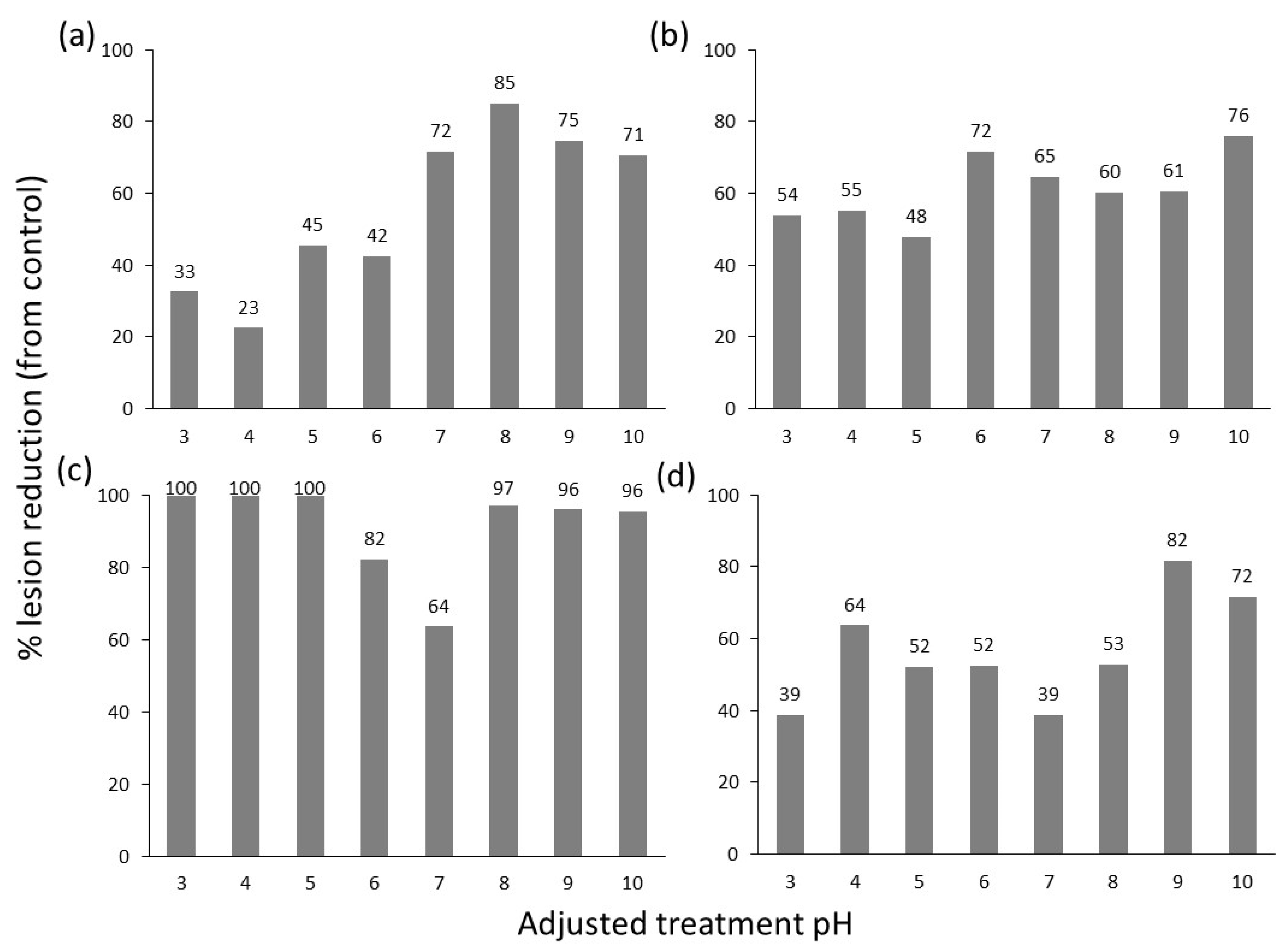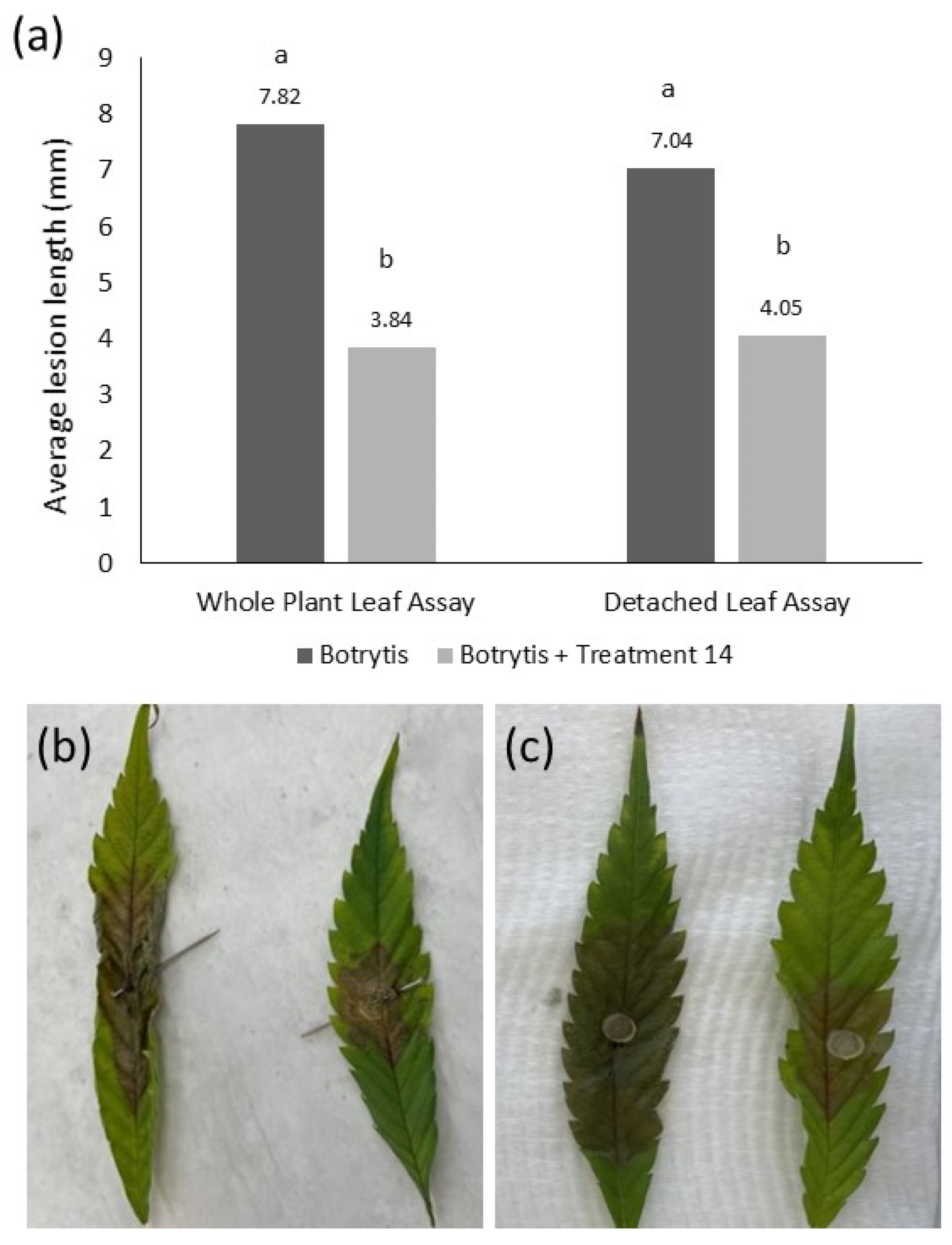Using Detached Industrial Hemp Leaf Inoculation Assays to Screen for Varietal Susceptibility and Product Efficacy on Botrytis cinerea
Abstract
:1. Introduction
2. Results
2.1. Detached Leaf Assay Optimisation—Leaf Wounding and Leaf Position
2.2. Detached Leaf Assay Screening for Varietal Resistance/Susceptibility
2.3. Detached Leaf Assay Screening of Active Ingredients
2.4. Product pH Significantly Affects Product Efficacy
2.5. Validation of Attached Leaf Assays Using Mature Plants
3. Discussion
4. Materials and Methods
4.1. Origin and Maintenance of Pathogen Isolate
4.2. Growth and Maintenance of Plant Material
4.3. Optimisation of Leaf Inoculation for Detached Leaf Assays
4.4. Detached Leaf Assay Screening for Varietal Susceptibility
4.5. Detached Leaf Assay Screening of Active Ingredients
4.6. Attached Leaf Assays Using Mature Plants
4.7. Statistical Analyses
Supplementary Materials
Author Contributions
Funding
Data Availability Statement
Acknowledgments
Conflicts of Interest
References
- McPartland, J.M.; Clarke, R.C.; Watson, D.P. Hemp Diseases and Pests: Management and Biological Control: An Advanced Treatise; CABI: Wallingford, UK, 2000. [Google Scholar]
- Jerushlami, S.; Maymon, M.; Dombrovsky, A.; Freeman, S. Effects of cold plasma, gamma and e-beam irradiations on reduction of fungal colony forming unit levels in medicianl cannabis inflorescence. J. Cannabis Res. 2020, 2, 12. [Google Scholar] [CrossRef] [PubMed]
- Small, E.; Marcus, D. Hemp: A new crop with new uses for North America. In Trends in New Crops and New Uses; ASHS Press: Alexandria, VA, USA, 2019; pp. 1–39. [Google Scholar]
- Jurgensen, C.W.; Masden, A.M. Exposure to the airborne mould Botrytis and its health effects. Ann. Agric. Environ. Med. 2009, 16, 83–196. [Google Scholar]
- Green, B.L.; Couch, J.R.; Lemons, A.R.; Burton, N.C.; Victory, K.R.; Nayak, A.P.; Beezold, D.H. Microbial hazards during harvesting and processing at an outdoor United States cannabis farm. J. Occup. Environ. Hyg. 2018, 15, 430–440. [Google Scholar] [CrossRef] [PubMed]
- Backer, R.G.; Mandolino, G.; Wilkins, O.; Elsohly, M.A.; Smith, D.L. Editorial: Cannabis genomics, breeding and production. Front. Plant Sci. 2020, 11, 591445. [Google Scholar] [CrossRef] [PubMed]
- Van Kan, J.A.L. Licensed to kill: The lifestyle of a necrotrophic plant pathogen. Trends Plant Sci. 2006, 5, 247–253. [Google Scholar] [CrossRef] [PubMed]
- Nicot, P.C.; Stewart, A.; Bardin, M.; Elad, Y. Biological control and biopesticide suppression of Botrytis-incited diseases. In Botrytis—The Fungus, the Pathogen and Its Management in Agricultural Systems; Springer International Publishing: Basel, Switzerland, 2016; pp. 165–187. [Google Scholar]
- Foolad, M.R.; Sullenberger, M.T.; Ashrafi, H. Detached-leaflet evaluation of tomato germplasm for late blight resistance and its correspondence to field and greenhouse screenings. Plant Dis. 2015, 99, 718–722. [Google Scholar] [CrossRef] [PubMed]
- Miller-Butler, M.A.; Smith, B.J.; Babiker, E.M. Comparison of Whole Plant and Detached Leaf Screening Techniques for Identifying Anthracnose Resistance in Strwberry Plants. Plant Dis. 2018, 102, 2112–2119. [Google Scholar] [CrossRef]
- Dolar, F.S.; Tenuta, A.; Higgins, V.J. Detached leaf assay for screening chickpea for resistance to Ascochyta blight. Can. J. Plant Pathol. 1994, 16, 215–220. [Google Scholar] [CrossRef]
- Yepes, L.M.; Aldwinckle, H.S. Selection of resistance to Venturia inaequalis using detached leaves from in vitro-grown apple shoots. Plant Sci. 1993, 93, 211–216. [Google Scholar] [CrossRef]
- Metcalf, D.A. Biological Control of Botrytis cinerea in Strawberry; Hort Innovation: Sydney, Australia, 2018; pp. 1–54. [Google Scholar]
- Chassot, C.; Buchala, A.; Schoonbeek, H.; Métraux, J.; Lamotte, O. Wounding of Arabidopsis leaves causes a powerful but transient protection against Botrytis infection. Plant J. 2008, 55, 555–567. [Google Scholar] [CrossRef]
- Grant, M.; Lamb, C. Systemic immunity. Plant Biol. 2006, 9, 414–420. [Google Scholar] [CrossRef] [PubMed]
- Govrin, E.M.; Levine, A. Infection of Arabidopsis with a necrotrophic pathogen, Botrytis cinerea, elicits various defense responses but does not induce systemic acquired resistance (SAR). Plant Mol. Biol. 2002, 48, 267–276. [Google Scholar] [CrossRef] [PubMed]
- Punja, Z.K. Flower and foliage-infecting pathogens of marijuana (Cannabis sativa L.) plants. Can. J. Plant Pathol. 2018, 40, 514–527. [Google Scholar] [CrossRef]
- European Medicines Agency. Guideline on Specifications: Test Procedures and Acceptance Criteria for Herbal Substances, Herbal Preparations and Herbal Medicinal Products/Traditional Herbal Medicinal Products. 2022. Available online: https://www.ema.europa.eu/en/specifications (accessed on 3 January 2023).
- Dryburgh, L.M.; Bolan, N.S.; Grof, C.P.L.; Galettis, P.; Schneider, J.; Lucas, C.J.; Martin, J.H. Cannabis contaminants: Sources, distribution, human toxicity and pharmacologic effects. Br. J. Clin. Pharmacol. 2018, 84, 2468–2476. [Google Scholar] [CrossRef] [PubMed]
- Hazekamp, A. Evaluating the Effects of Gamma-Irradiation for Decontamination of Medicinal Cannabis. Front. Pharmacol. 2016, 7, 108. [Google Scholar] [CrossRef] [PubMed]
- Frost, E.H.; Shutler, D.; Hillier, N.K. Effects of fluvalinate on honey bee learning, memory, responsiveness to sucrose, and survival. J. Exp. Biol. 2013, 216, 2931–2938. [Google Scholar] [CrossRef] [PubMed]
- Markoglou, A.N.; Ziogas, B.N. SBI-fungicides: Fungicidal effectiveness and resistance in Botrytis cinerea. Phytopathol. Mediterr. 2002, 41, 120–130. [Google Scholar]
- Lucas, J.A.; Hawkins, N.J.; Fraaije, B.A. Chapter Two—The Evolution of Fungicide Resistance. Adv. Appl. Microbiol. 2015, 90, 29–92. [Google Scholar] [CrossRef]
- Boumaaza, B.; Benkhelifa, M.; Belkhoudja, M. Effects of Two Salts Compounds on Mycelial Growth, Sporulation, and Spore Germination of Six Isolates of Botrytis cinerea in the Western North of Algeria. Int. J. Microbiol. 2015, 2015, 572626. [Google Scholar] [CrossRef]
- Calvo-Garrido, C.; Elmer, P.A.G.; Parry, F.J.; Viñas, I.; Usall, J.; Torres, R.; Agnew, R.H.; Teixidó, N. Mode of action of a fatty acid–based natural product to control Botrytis cinerea in grapes. J. Appl. Microbiol. 2014, 116, 967–979. [Google Scholar] [CrossRef]
- Puritch, G.S.; Tan, W.C.; Hopkins, J.C. Effect of fatty acid salts on the growth of Botrytis cinerea. Can. J. Bot. 1981, 59, 491–494. [Google Scholar] [CrossRef]
- Geng, L.; Fu, Y.; Peng, X.; Yang, Z.; Zhang, M.; Song, Z.; Guo, N.; Chen, S.; Chen, J.; Bai, B.; et al. Biocontrol potential of Trichoderma harzianum against Botrytis cinerea in tomato plants. Biol. Control. 2002, 174, 105019. [Google Scholar] [CrossRef]
- Vos, C.M.F.; Cremer, K.D.; Cammue, B.P.A.; Coninck, B.D. The toolbox of Trichoderma spp. in the biocontrol of Botrytis cinerea disease. Mol. Plant Pathol. 2015, 16, 400–412. [Google Scholar] [CrossRef] [PubMed]
- Palmer, C.L.; Horst, K.R.; Langhans, R.W. Use of Bicarbonates to Inhibit in vitro Colony Growth of Botrytis cinerea. Plant Dis. 1997, 81, 1339–1472. [Google Scholar] [CrossRef] [PubMed]
- Kaiser, C.; Hamm, P.B.; Gieck, S.; David, N.; Long, L.; Meland, M.; Christensen, J.M. In Vitro Fungicidal Activity of Calcium and Potassium Salts on Several Commercially Significant Plant Pathogens. HortScience 2011, 46, 913–916. [Google Scholar] [CrossRef]
- Bekker, T.F.; Kaiser, C.; Labuschagne, N. The antifungal activity of potassium silicate and the role of pH against selected plant pathogenic fungi in vitro. S. Afr. J. Plant Soil 2009, 26, 55–57. [Google Scholar] [CrossRef]
- Lamichhane, J.R.; Osdaghi, E.; Behlau, F.; Köhl, J.; Jones, J.B.; Aubertot, J. Thirteen decades of antimicrobial copper compounds applied in agriculture: A review. Agron. Sustain. Dev. 2018, 38, 28. [Google Scholar] [CrossRef]





| Leaf Position | Average Lesion Length (mm/day) |
|---|---|
| 1 | 5.875 a (range, 5.4–6.7) |
| 2 | 5.975 a (range, 4.5–7.0) |
| 3 | 6.337 a (range, 5.0–7.5) |
| 4 | 6.225 a (range, 5.0–7.5) |
| 5 | 5.587 a (range, 4.5–6.6) |
| p-value | 0.076 |
| LSD | 0.5572 |
| Replicates (n) | 40 |
| Hemp Variety | Average Lesion Length (mm/day) | |
|---|---|---|
| Experiment A | Experiment B | |
| SI-1 | 9.78 a | 9.00 b |
| YUMA | 10.42 a | 7.89 a |
| HAN NW | 10.49 b | 9.80 c |
| BAMA | 10.64 b | 9.01 b |
| HAN NE | 10.67 b | 10.62 c |
| PUMA | 10.69 b | 10.54 c |
| HAN FNH | 10.80 b | 9.61 c |
| HAN FNQ | 11.83 c | 10.62 c |
| p-value | <0.001 | <0.001 |
| LSD | 0.661 | 0.990 |
| Replicates (n) | 20 | 20 |
| Treatment No. | Active Ingredients (AIs) | Label Rate |
|---|---|---|
| 1 | Trichoderma harzianum | 1 g/700 mL |
| 2 | 633 g/kg Potassium Bicarbonate, 312 g/kg Potassium Silicate | 4 g/L |
| 3 | 940 g/kg Potassium Bicarbonate | 3.8 g/L |
| 4 | 194 g/L Potassium Salts of Fatty Acids | 200 mL/L |
| 5 | 633 g/kg Potassium Bicarbonate, 312 g/kg Potassium Silicate + 194 g/L Potassium Salts of Fatty Acids | 4 g/L and 200 mL/L |
| 6 | 10% Soybean Oil, 5% Corn Oil, 85% Water, Guar Gum, Glycerine, Citric Acid, Soap, Vanillin | 57 g/4.5 L |
| 7 | 0021% w/v Available Chlorine | Premixed |
| 8 | 0.167 g/L Difenoconazole, 0.100 g/L Thamethoxam, 0.015 g/L Abamectin | Premixed |
| 9 | 25% w/w Copper as Sulphate, 12% Sulphur as Sulphate | 10 g/L |
| 10 | Apple Cider Vinegar | 10 mL/L |
| 11 | 3% Hydrogen Peroxide | Premixed |
| 12 | 11.82 g/L Azadirachtin A and B present as 29.55 g/L Azadirachta indica extract | 10 mL/5 L |
| 13 | 100% Sodium Bicarbonate | 1 g/L |
| 14 | 1 g/L Tau-fluvalinate, 0.05 g/L Myclobutanil | Premixed |
| 15 | 5 g/L Spinetoram in the form of a suspension concentrate | 5 mL/L |
| 16 | 150 g/L Prothioconazole, 75 g/L Bixafen, 523 g/L N, N Dimethyldecanamide | 0.9 mL/L |
| 17 | Monocalcium Phosphate, Sodium Bicarbonate, and Corn Starch (Baking powder) | Premixed |
| 18 | 9.0 g/L Tau-Fluvalinate, 4.4 g/L Myclobutanil | 7.5 mL/L |
| 19 | 100% Citric Acid | 1 g/L |
| 20 | 0.1 g/L Tau-fluvalinate, 0.05 g/L Myclobutanil | Premixed |
| 21 | 10–30% w/w Phosphoric Acid, Monopotassium Salt | 6 mL/L |
| 22 | 93 g/L Copper–Ammonium Complex | 10 g/L |
| Treatment No. | Optimal pH | Average Percent Lesion Reduction | SE |
|---|---|---|---|
| 5 | 8 | 83.5 | 6.1 |
| 8 | 10 | 79.8 | 5.5 |
| 9 | 9 | 89.1 | 6.4 |
| 14 | 9 | 83.5 | 4.3 |
Disclaimer/Publisher’s Note: The statements, opinions and data contained in all publications are solely those of the individual author(s) and contributor(s) and not of MDPI and/or the editor(s). MDPI and/or the editor(s) disclaim responsibility for any injury to people or property resulting from any ideas, methods, instructions or products referred to in the content. |
© 2023 by the authors. Licensee MDPI, Basel, Switzerland. This article is an open access article distributed under the terms and conditions of the Creative Commons Attribution (CC BY) license (https://creativecommons.org/licenses/by/4.0/).
Share and Cite
Kirkby, K.; Roser, S.; Plett, K. Using Detached Industrial Hemp Leaf Inoculation Assays to Screen for Varietal Susceptibility and Product Efficacy on Botrytis cinerea. Plants 2023, 12, 3278. https://doi.org/10.3390/plants12183278
Kirkby K, Roser S, Plett K. Using Detached Industrial Hemp Leaf Inoculation Assays to Screen for Varietal Susceptibility and Product Efficacy on Botrytis cinerea. Plants. 2023; 12(18):3278. https://doi.org/10.3390/plants12183278
Chicago/Turabian StyleKirkby, Karen, Sharlene Roser, and Krista Plett. 2023. "Using Detached Industrial Hemp Leaf Inoculation Assays to Screen for Varietal Susceptibility and Product Efficacy on Botrytis cinerea" Plants 12, no. 18: 3278. https://doi.org/10.3390/plants12183278
APA StyleKirkby, K., Roser, S., & Plett, K. (2023). Using Detached Industrial Hemp Leaf Inoculation Assays to Screen for Varietal Susceptibility and Product Efficacy on Botrytis cinerea. Plants, 12(18), 3278. https://doi.org/10.3390/plants12183278






